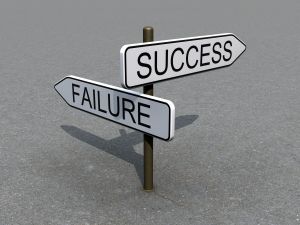
Why Failure Drives Innovation
Silicon Valley is populated with people who fear only sitting on the bench while someone else scores with a great idea, says Professor Baba Shiv. How people approach failure is a key to success, he argues
"Failure" is a dreaded concept for most business people. But failure can actually be a huge engine of innovation for an individual or an organization. The trick lies in approaching it with the right attitude and harnessing it as a blessing, not a curse.
I've coined two terms that describe how people view failure: the type 1 mindset, and the type 2 mindset.
The type 1 mindset is fearful of making mistakes. It characterizes most individuals, managers, and corporations today. In this mindset, to fail is shameful and painful. Because the brain becomes very risk averse under this line of thinking, innovation is generally nothing more than incremental. You don't get off-the-charts results.
The type 2 mindset is fearful of losing out on opportunities. Places like Silicon Valley and the Stanford Graduate School of Business are full of type 2s. What is shameful to these people is sitting on the sidelines while someone else runs away with a great idea. Failure is not bad; it can actually be exciting. From so-called "failures" emerge those valuable gold nuggets — the "aha!" moments of insight that guide you toward your next innovation.
We generally start out with the type 2 adventurous spirit as children. But then somewhere along the line, often in school, we are squelched. Failure is not allowed. We become type 1s.
So how do you get people and corporations to shift from 1 to 2?
One approach is to engage them in rapid prototyping — the process whereby they brainstorm wild new ideas, and then quickly develop a physical model or mock-up of a solution. This allows people to move quickly from the abstract to the concrete, and lets them visualize the outcome of their ideas. It gives the brain richer inputs.
Because not all prototypes end up as the best or final solution, rapid prototyping also teaches that failure is actually a necessary part of the process. You may chuck an idea and say, "Let's try something else," but you keep moving in a positive way. This whips the brain into associating "failure" with pleasure.
Another way to shift people into type 2 thinking is, paradoxically, to instill in them a sense of "desperation." This is done by cutting resources so that they are forced to devise new solutions. As we know, necessity is the mother of invention.
In India, where we have known lack for centuries, the practice of "jugad" is part of the management lexicon. It refers to the inventive approach people must take to manage the scarcity that is so often a part of the landscape.
Anheuser-Busch InBev stimulates a kind of "jugad" mentality each year by decreasing the advertising team's budget while demanding increased performance. Following a period of desperation, the team is spurred to look at new, less expensive ways of communicating its message.
Many corporations try to use the opposite of desperation — inspiration — as a means of stimulating innovation. It sounds good, but sometimes it doesn't work. Often, fostering "inspiration" means putting a pool of type 2s into a closed environment where they are given license to prototype away. But then they end up presenting their ideas to whom? Type 1s. And such fearful managers shoot them down every time.
To make inspiration work as a motivator, take a look at Cisco Systems. There, type 2s are given the space and support to prototype, but they must have someone from senior management on their team. By getting such managers involved in the process, innovators have a champion who can navigate the political system and sell the idea better.
Another good example of using inspiration is TSYS Acquiring Solutions, a company that for a small fee carries out the first credit/debit card transaction at any counter by transmitting the data to the networks and banks. To diversify their business, they developed an ingenious way to reward innovation in the corporate culture. Each employee is given "TSYS dollars" to "invest" in creative solutions posed by internal teams on the company intranet. The most heavily invested idea is actually implemented. By turning innovators into company icons, they encourage others to submit new solutions.
Business schools are now teaching rapid prototyping as a way to instill type 2 thinking. In my Frinky Science of the Human Mind course at the Stanford Graduate School of Business, students used this technique to apply the principles of human brain functioning toward figuring out how customers can be made to feel comfortable with their buying experience and thereby choose one product over another. In our executive program, senior managers have developed prototype solutions for how airlines might better handle delays with customers.
The bottom line: Failure is not bad. The sooner companies realize this, the sooner they will be on the road to breakthrough thinking.
This piece originally appeared in Stanford Business Insights from Stanford Graduate School of Business. To receive business ideas and insights from Stanford GSB click here: (To sign up: https://www.gsb.stanford.edu/insights/about/emails)





